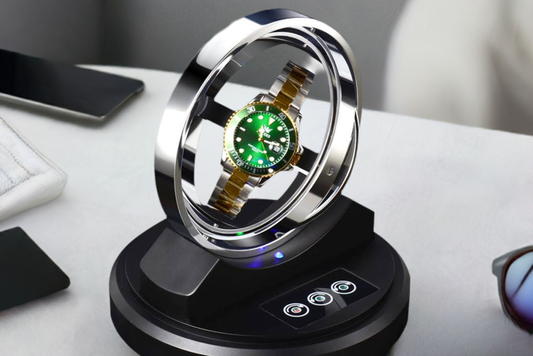Mechanical watches are an exquisite fusion of art, engineering, and heritage, transcending mere timekeeping to become captivating works of craftsmanship. Meticulously crafted and technically intricate, they often undergo meticulous hand assembly, comprising hundreds of meticulously crafted components. With a rich history spanning centuries, owning a mechanical watch signifies more than a timepiece; it embodies luxury, sophistication, and an appreciation for unparalleled craftsmanship.
Power reserve refers to the length of time a watch can run without being wound. For watches made after 1870, watches are usually designed with a 30-40 hour "power reserve", which means that once fully wound, they can run for approx. 30-40 hours.
How to wind a watch?
Begin by gently turning the crown of the watch until you feel resistance, indicating that the mainspring is fully wound. Exercise caution as you continue winding, ensuring not to over-tighten or force the mechanism. This delicate touch preserves the intricate components within the watch, allowing for smooth operation and longevity.
For those seeking optimal accuracy, a daily winding ritual is recommended. By winding the watch once a day, preferably at the same time each day, you ensure that the mainspring remains consistently tensioned, promoting precise timekeeping. However, it's essential to note that adherence to a strict winding schedule does not shield the watch from potential damage or issues. Instead, it maintains the mainspring's optimal tension, enhancing the watch's accuracy.
Credit: YouTube Channel - Timed Square
Several factors and suggestions that affect the winding frequency of mechanical watches:
1. Daily Wear: When you wear a mechanical watch regularly, the natural movement of your wrist winds the watch. When you move, a rotor inside the watch spins, winding the mainspring and storing energy. If you lead an active lifestyle, you may not need to manually wind it.
Suggestion: Wear your watch for at least 10-12 hours a day to maintain its power.
2. Power reserve indicator: Some mechanical watches are equipped with a power reserve indicator. This feature displays the remaining power reserve, allowing you to monitor when your watch needs to be wound. If your watch is equipped with this indicator, it will be easier to determine the best time to wind it.
Suggestion: Check the power reserve indicator every morning or evening.
3. Rest and Storage: If you don't wear your mechanical watch regularly or plan to store it for long periods of time, manual winding is essential. When the watch is idle, the power reserve gradually depletes, eventually causing it to stop. Winding the watch before wearing it ensures that the watch runs smoothly and maintains accurate timekeeping.
Suggestion: Fully wind your watch before storing it or if it has been unused for more than a week.
Conclusion
Understanding how often to wind a mechanical watch is crucial to preserving its performance and accuracy. By factoring in daily wear, monitoring power reserve indicators, and addressing periods of inactivity, enthusiasts can ensure their timepieces remain in pristine condition for generations to come. Embrace the art of winding, and let your mechanical watch tell its timeless story with precision and grace.




